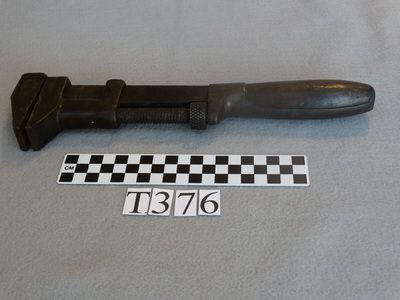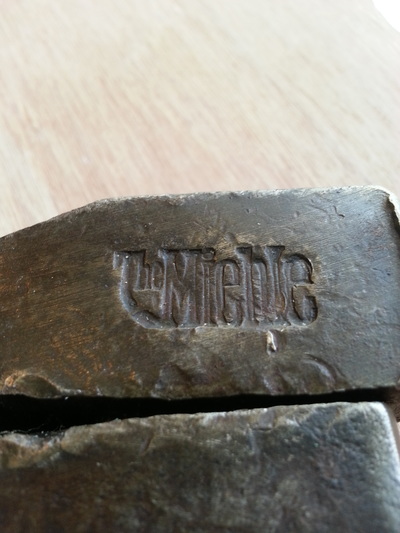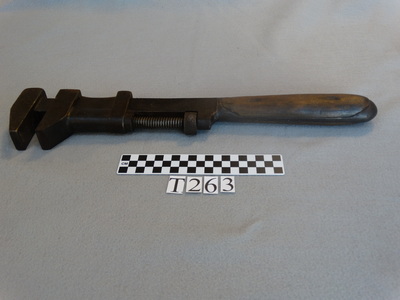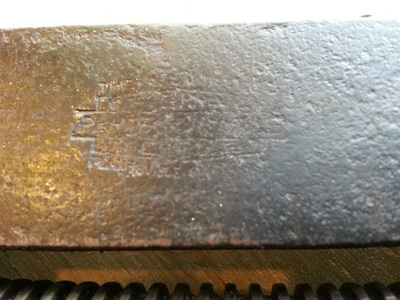|
Here are a couple of monkey wrenches from the Tison Tool Barn with markings that I could not identify at first in searches of the Internet. First is the wrench below, which had only the marking shown in the right-hand photo. This wrench, which is 12 inches long, has only the mark shown in the right-hand photo. Although the mark is quite deep, I had trouble deciphering it. In particular, I could not tell whether the two vertical lines were the letter "i" or "l". Trying different combinations of those letters, I finally got a couple of hits on "Mieble", a manufacturer of printing presses. And then I noticed that one web page had both "Mieble" and "Miehle". The fourth letter in the name was "h", not "b". It appears that I am not the only one who has had trouble deciphering this mark. The Miehle Printing Press and Manufacturing Company was an important producer of printing presses from late in the 19th century until well into the 20th century. While I have not found a history or other substantial article about the company on the Internet, it's presses seem to have been well regarded. There is no indication that the Miehle company produced wrenches or any other tools. So, how did this wrench come to be stamped with "The Miehle"? Early in the 20th century wrenches and other tools were included as part of the equipment provided with automobiles and farm equipment. Such wrenches were often stamped with the name of the automobile or farm equipment manufacturer rather than the company that produced the wrench. This was common enough that monkey wrenches were often referred to as "Ford wrenches". While I have not found any source that indicates that the Miehle company provided at least a wrench, and possibly other tools, with its presses, this does seem to be a reasonable explanation for the mark on this wrench. Another wrench also baffled me at first. This wrench, in the left-hand photo below, had an elaborate but badly worn mark, shown in the right-hand photo below. This wrench, which is 18-1/2 inches long, has a badly worn mark on it. Mel MIller, in the Antique and Vintage Tools Forum on Facebook, was able to identify this mark as the logo for the H. D. Smith & Co. Perfect Handle line, perhaps best known by collectors and woodworkers for its screw drivers. However, H. D. Smith & Co. first used Perfect Handles on their wrenches. Perfect Handle wrenches were based on U. S. patents D33,468, 666,029 and D34,136, which were issued in 1900 and 1901, which means that all Perfect Handle tools were produced in the 20th century. The Perfect Handle was forged as part of the bar of the wrench. It was a flat frame as wide as the handle in the plane in which the wrench was turned when tightening or loosening a nut. Two pieces of wood were fastened to the frame to provide a comfortable grip for the user. Earlier wrench handles were generally in the shape of a rod running down the center of a wooden handle, and could be bent if too much force was applied. The shape of the Perfect Handle was much more resistant to bending. Similar handles, often called knife handles, came into use for other monkey wrenches. The term "perfect handle" is sometimes used for any tool handle with wood inserts on a metal frame, but the trade mark "Perfect Handle" was used only by H. D. Smith & Co. I will be looking at more monkey wrenches from the Tison Tool Barn in my next post.
0 Comments
|
AuthorI have been a volunteer at the Matheson History Museum. Feeling an affinity with old hand tools (some of which I remember from my youth), I have tried to learn more about the history of the tools in the Tison Tool Barn, and how they were used. All text and photographs by Donald Albury in this blog are licensed under a Creative Commons Attribution-ShareAlike 4.0 International License. All illustrations taken from Wikimedia Commons are either in the public domain, or have been released under a Creative Commons license.
Archives
December 2015
Categories
All
Interesting Sites about Old Tools |




 RSS Feed
RSS Feed
